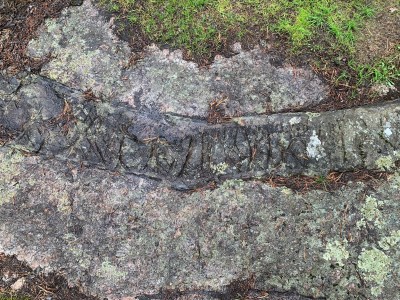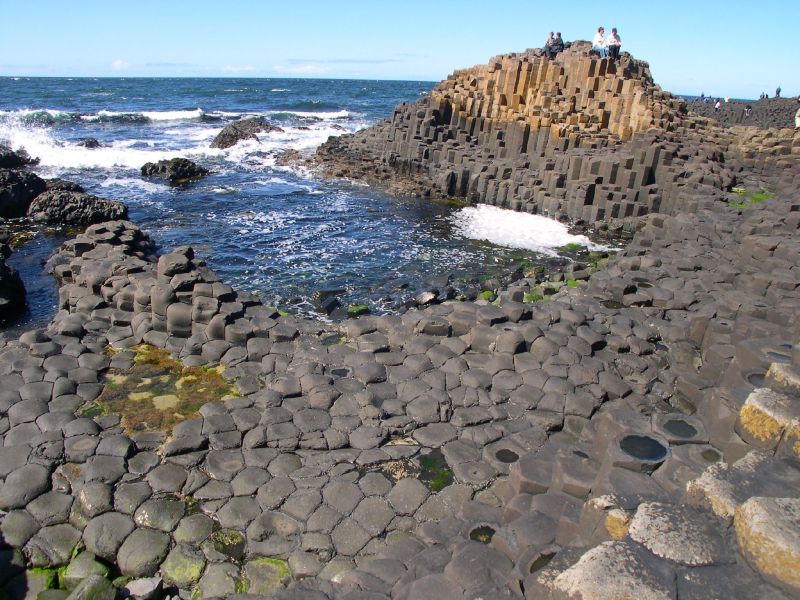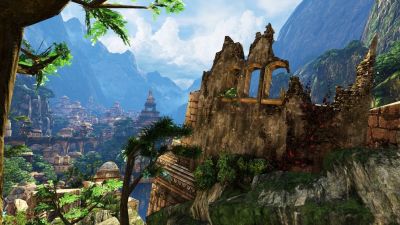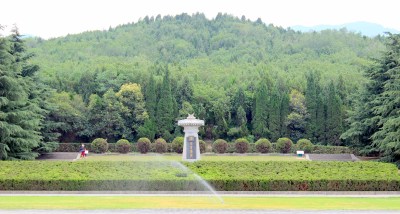History is rather dull and unexciting to most people, which naturally invites exciting flights of fancy that can range from the innocent to outright conspiracies. Nobody truly believes that the astounding finds and (fully functioning) ancient mechanisms in the Indiana Jones and Uncharted franchises are real, with mostly intact ancient cities waiting for intrepid explorers along with whatever mystical sources of power, wealth or influence formed the civilization’s foundations before its tragic demise. Yet somehow Plato’s fictive Atlantis has taken on a life of its own, along with many other ‘lost’ civilizations, whether real or imagined.
Of course, if these aforementioned movies and video games were realistic, they would center around a big archaeological dig and thrilling finds like pot shards and cuneiform clay tablets, not ways to smite enemies and gain immortality. Nor would it involve solving complex mechanical puzzles to gain access to the big secret chamber, prior to walking out of the readily accessible backdoor. Reality is boring like that, which is why there’s a major temptation to spruce things up. With the Egyptian pyramids as well as similar structures around the world speaking to the human imagination, this has led to centuries of half-baked ideas and outright conspiracies.
Most recently, a questionable 2022 paper hinting at structures underneath the Pyramid of Khafre in Egypt was used for a fresh boost to old ideas involving pyramid power stations, underground cities and other fanciful conspiracies. Although we can all agree that the ancient pyramids in Egypt are true marvels of engineering, are we really on the cusp of discovering that the ancient Egyptians were actually provided with Forerunner technology by extraterrestrials?
The Science of Being Tragically Wrong

In defense of fanciful theories regarding the Actual Truth™ about Ancient Egypt and kin, archaeology as we know it today didn’t really develop until the latter half of the 20th century, with the field being mostly a hobbyist thing that people did out of curiosity as well as a desire for riches. Along the way many comical blunders were made, such as the Runamo runes in Sweden that turned out to be just random cracks in dolerite.
Less funny were attempts by colonists to erase Great Zimbabwe (11th – ~17th century CE) and the Kingdom of Zimbabwe after the ruins of the abandoned capital were discovered by European colonists and explored in earnest by the 19th century. Much like the wanton destruction of local cultures in the Americas by European colonists and explorers who considered their own culture, religion and technology to be clearly superior, the history of Great Zimbabwe was initially rewritten so that no thriving African society ever formed on its own, but was the result of outside influences.
In this regard it’s interesting how many harebrained ideas about archaeological sites have now effectively flipped, with mystical and mythical properties being assigned and these ‘Ancients’ being almost worshipped. Clearly, aliens visited Earth and that led to pyramids being constructed all around the globe. These would also have been the same aliens or lost civilizations that had technology far beyond today’s cutting edge, putting Europe’s fledgling civilization to shame.
Hence people keep dogpiling on especially the pyramids of Giza and its surrounding complex, assigning mystical properties to their ventilation shafts and expecting hidden chambers with technology and treasures interspersed throughout and below the structures.
Lost Technology

The idea of ‘lost technology’ is a pervasive one, mostly buoyed by the axiom that you cannot disprove something, only find evidence for its absence. Much like the possibility of a teapot being in orbit around the Sun right now, you cannot disprove that the Ancient Egyptians did not have hyper-advanced power plants using zero point energy back around 3,600 BCE. This ties in with the idea of ‘lost civilizations‘, which really caught on around the Victorian era.
Such romanticism for a non-existent past led to the idea of Atlantis being a real, lost civilization becoming pervasive, with the 1960s seeing significant hype around the Bimini Road. This undersea rock formation in the Bahamas was said to have been part of Atlantis, but is actually a perfectly cromulent geological formation. More recently a couple of German tourists got into legal trouble while trying to prove a connection between Egypt’s pyramids to Atlantis, which is a theory that refuses to die along with the notion that Atlantis was some kind of hyper-advanced civilization and not just a fictional society that Plato concocted to illustrate the folly of man.
Admittedly there is a lot of poetry in all of this when you consider it from that angle.

People have spent decades of their life and countless sums of money on trying to find Atlantis, Shangri-La (possibly inspired by Shambhala), El Dorado and similar fictional locations. The Iram of the Pillars which featured in Uncharted 3: Drake’s Deception is one of the lost cities mentioned in the Qur’an, and is incidentally another great civilization that saw itself meet a grim end through divine punishment. Iram is often said to be Ubar, which is commonly known as Atlantis of the Sands.
All of this is reminiscent of the Giant’s Causeway in Northern Ireland, and corresponding area at Fingal’s Cave on the Scottish isle of Staffa, where eons ago molten basalt cooled and contracted into basalt columns in a way that is similar to how drying mud will crack in semi-regular patterns. This particular natural formation did lead to many local myths, including how a giant built a causeway across the North Channel, hence the name.
Fortunately for this location, no ‘lost civilization’ tag became attached, and thus it remains a curious demonstration of how purely natural formations can create structures that one might assume to have required intelligence, thus providing fuel for conspiracies. So far only ‘Young Earth’ conspiracy folk have put a claim on this particular site.
What we can conclude is that much like the Victorian age that spawned countless works of fiction on the topic, many of these modern-day stories appear to be rooted in a kind of romanticism for a past that never existed, with those affected interpreting natural patterns as something more in a sure sign of confirmation bias.
Tourist Traps

One can roughly map the number of tourist visits with the likelihood of wild theories being dreamed up. These include the Egyptian pyramids, but also similar structures in what used to be the sites of the Aztec and Maya civilizations. Similarly the absolutely massive mausoleum of Qin Shi Huang in China with its world-famous Terracotta Army has led to incredible speculation on what might still be hidden inside the unexcavated tomb mound, such as entire seas and rivers of mercury that moved mechanically to simulate real bodies of water, a simulated starry sky, crossbows set to take out trespassers and incredible riches.
Many of these features were described by Sima Qian in the first century BCE, who may or may not have been truthful in his biography of Qin Shi Huang. Meanwhile, China’s authorities have wisely put further excavations on hold, as they have found that many of the recovered artefacts degrade very quickly once exposed to air. The paint on the terracotta figures began to flake off rapidly after excavation, for example, reducing them to the plain figures which we are familiar with.
Tourism can be as damaging as careless excavation. As popular as the pyramids at Giza are, centuries of tourism have taken their toll, with vandalism, graffiti and theft increasing rapidly since the 20th century. The Great Pyramid of Khufu had already been pilfered for building materials over the course of millennia by the local population, but due to tourism part of its remaining top stones were unceremoniously tipped over the side to make a larger platform where tourists could have some tea while gazing out over the the Giza Plateau, as detailed in a recent video on the History for Granite channel:
The recycling of building materials from antique structures was also the cause of the demise of the Labyrinth at the foot of the pyramid of Amenemhat III at Hawara. Once an architectural marvel, with reportedly twelve roofed courts and spanning a total of 28,000 m2, today only fragments remain of its existence. This sadly is how most marvels of the Ancient World end up: looted ruins, ashes and shards, left in the sand, mud, or reclaimed by nature, from which we can piece together with a lot of patience and the occasional stroke of fortune a picture what it once may have looked like.
Pyramid Power

When in light of all this we look at the claims made about the Pyramid of Khafre and the persistent conspiracies regarding this and other pyramids hiding great secrets, we can begin to see something of a pattern. Some people have really bought into these fantasies, while for others it’s just another way to embellish a location, to attract more rubes tourists and sell more copies of their latest book on the extraterrestrial nature of pyramids and how they are actually amazing lost technologies. This latter category is called pseudoarcheology.
Pyramids, of course, have always held magical powers, but the idea that they are literal power plants seems to have been coined by one Christopher Dunn, with the publication of his pseudo-archeological book The Giza Power Plant in 1998. That there would be more structures underneath the Pyramid of Khafre is a more recent invention, however. Feeding this particular flight of fancy appears to be a 2022 paper by Filippo Biondi and Corrado Malanga, in which synthetic aperture radar (SAR) was used to examine said pyramid interior and subsurface features.
Somehow this got turned into claims about multiple deep vertical wells descending 648 meters along with other structures. Shared mostly via conspiracy channels, it widely extrapolates from claims made in the paper by Biondi et al., with said SAR-based claims never having been peer-reviewed or independently corroborated. On the Rational Wiki entry for these and other claims related to the Giza pyramids are savagely tossed under the category of ‘pyramidiots’.

Back in the real world, archaeologists have found a curious L-shaped area underneath a royal graveyard near Khufu’s pyramid that was apparently later filled in, but which seems to lead to a deeper structure. This is likely to be part of the graveyard, but may also have been a feature that was abandoned during construction. Currently this area is being excavated, so we’re likely to figure out more details after archaeologists have finished gently sifting through tons of sand and gravel.
There is also the ScanPyramids project, which uses non-destructive and non-invasive techniques to scan Old Kingdom-era pyramids, such as muon tomography and infrared thermography. This way the internal structure of these pyramids can be examined in-depth. One finding was that of a number of ‘voids’, which could mean any of a number of things, but most likely do not contain world-changing secrets.
To this day the most credible view is still that the pyramids of the Old Kingdom were used as tombs, though unlike the mastabas and similar tombs, there is a credible argument to be made that rather than being designed to be hidden away, these pyramids would be eternal monuments to the pharaoh. They would be open for worship of the pharaoh, hence the ease of getting inside them. Ironically this would make them more secure from graverobbers, which was a great idea until the demise of the Ancient Egyptian civilization.
This is a point that’s made succinctly on the History for Granite channel, with the conclusion being that this goal of ‘inspiring awe’ to worshippers is still effective today, simply judging by the millions of tourists each year to these monuments, and the tall tales that they’ve inspired.
















Should just ignore these cranks rambling about granola-powered new age hippie dynamos under the pyramids and just dig up the rest of the Gobekli Tepe complex. And sanction Australia until they stop annihilating some of the oldest and most important hominid fossils just because some guys huffing ether in a trailer tell them to. And run lots more ancient human genomes
Your posting may constitute a somewhat ironic use of the term “cranks”.
“Crank” to you means anybody who cares about anything
Hey Posch. I’ve been critical of you in the past but whatever you are doing to write these interesting, longer form articles like this- keep it up. Thanks. This article is fun.
also… “but is actually a perfectly cromulent geological formation.” nice.
All this time and the US Govt is still trying to cover up the truth about the Stargate project and the influence of the Goa’uld throughout history. Shameful.
“The goooold”
—General Hammond
Finally, someone calling out Homer/Scully’s Dad’s pronunciation!
Ba’al does not equal ‘Ball’. I’m looking at you Teal’c
False dead gods
Yes, but by the end of the series hundreds of civilians had stumbled onto the truth. How did they manage to keep it quiet all these years? Surely they didn’t ship them all to the Alpha site.
As I read I thought this was going to turn out to be the HaD April 1 article!
It’s not less offensive because it’s April 1st.
How is this article offensive?
I suppose it’s offensive to those the shoe fits to.
Some types of offensivenesses are OK.
Now I wonder if there could theoretically be an alien civilisation out there who are obsessively tidy.
I mean.. why not?
” it was in no way a rational construction, as one might think with our current concepts.”
I don’t think you can say there is much rationality to funerals currently. And droves of people basically still cling to the ‘eternal life’ thing even today, applied in various religions as well as the more general ‘reincarnation’ notion.
It’s all a bit embarrassing isn’t it.
Funeral is more of ritual, than anything else. And later a remembrance marker for the family/relatives. So – the only rationalisation here is tradition.
PS. Not taking the religion part – life is relatively short, you’ll either find out that there is something after it. Or not.
Once again my various replies don’t go to the right spot but get bunched under a single comment it seem.
It’s the free HaD puzzle, find out where the replies belongs and have hours of fun doing so!
If people think history is boring, they’re reading the wrong history.
I stopped by to make that very point. History is only “boring” when it’s taught as though it came from a phone directory or dictionary.
Years ago, when I studied for my EE degree, I had to take some “liberal arts” courses. I chose history. The rules in this particular class were novel: The professor lectured, and each week he’d pose a question that you had to answer in long-essay form. At the end of the course, for your grade, you either turned in that collection of essays or, if you chose not to do any of that essay work, you took a final exam.
With those ground rules in place, there was no busy-work to get in the way of his story-telling. He didn’t just cite dates and battles. He told you what people of that period were thinking, eating, what they wore, how they entertained themselves, and what kind of jokes were regarded as funny. He not only turned black-and-white photos and legends into real, living people, he made their decisions and actions understandable, if not agreeable. I used to look forward to going to this guy’s class because listening to him talk was like watching a really good TV show. Fantastic.
I ended up taking two or three terms with this guy and learned more about Western history in that limited period than I had in the prior decade.
Similar experience, I looked forward to the non-technical elective courses in history and literature precisely because they were fascinating and tickled a part of my brain that my EE courses just didn’t. I took courses on everything from native american culture to eastern religions and by far my favorite was a literature class on science fiction.
In 8th grade, had a fantastic history teacher. Instead of the usual too-broad overview of centuries, we dove deep into two historical events: the Salem Witch trial and the Boston Tea Party. Primary sources, draw your own conclusions, the whole shebang.
It was about how history is done more than just reading the output of historians, and it was super eye-opening.
And in the end, of course, I remember more detail about both events than I have any need to!
We had the same requirement.
So I checked, best ratio in a liberal arts program: Psychology…B@#$~! be crazy.
Guess what?
Every engineer had run the same algorithm in previous years.
We could pick any liberal arts focus area we wanted, except psych.
Bastards!
It was because we blew the curve for as long as we were there…
By the forth psych course, all the actual psych majors were switching to easier majors.
I still blew the curve in Econ, but the teacher just set the curve were the mass of business majors were scoring.
Articles like this are proof our Lizard overlords are trying desperately to conceal the truth about the secrets of the pyramids.They know once we discover the aethereal fusion power plants radiating Ley Lines from each pyramid that we will surpass their technology.
Oh, and btw the Earth really is flat.
Yeah, right :)
We “serve” Crab People, not Lizards, get it right. Someday we will rise up and serve Crab People on a silver platter with melted butter, but until then keep your head down and your eyes and ears open.
its funny i was watching a video on the silurian hypothesis, and youtube thought it would be cool to put an out of context context bubble about lizzard people. the vril-ya are not happy.
The only reason they’re keeping that technology away from us is because they know we’re only going to use it to boil water. Such a shame.
A “must read” in this area is The Secret Teachings Of All Ages by Manly Hall e.g.”https://archive.org/details/TheSecretTeachingsOfAllAgesManlyHall/page/n79/mode/2up”
I found this quite shocking to read, not because it’s in any way true (in the literal sense), but because of the realisation that there are a load of people out there who actually believe this stuff.
Not just your internet kooks, but important and powerful people like judges, high-end financiers, bankers, probably some politicians etc. You only have to look around you for Masonic halls and the like, there you’ll find an enclave of believers.
This is why we need to spend more resources on providing global mental health resources
“quite shocking … the realisation that there are a load of people out there who actually believe this stuff.”
Like we needed reminding …
I did some work at the local “hall”, it had kind of a good old boy meets “wanna-be” catholic with a little lizard people and ‘win the lotto’ vibe.
Maybe this is why the polymath or Renaissance man is such a good character, they cut right through this stuff with science. Although counterpoint is Dr Who where everything is hilarious, tongue in cheek I guess. I enjoyed a lot of X-Files, but don’t believe any of that stuff. Skipped the poorly written episodes with the “astral/beyond” junk. Thoroughly enjoyed the spin-off “Lone Gunmen”.
You were doing well up until the “Masons!” bit.
Great hacks, those ancients…
Very interesting article !
But :
“…there is a credible argument to be made that rather than being designed to be hidden away, these pyramids would be eternal monuments to the pharaoh. They would be open for worship of the pharaoh, hence the ease of getting inside them.”
It’s a little more complicated than that, and I’m a little disappointed that the author of the article would indulge in such an oversimplification, which detracts from the overall quality of the article, which is otherwise very well thought out.
First of all, in Egypt, a pyramid is only one element of a funerary complex. It is, in particular, the most sacred and respected element, but above all, the most visible—and therefore the best known.
The funerary complex was designed according to the symbols and beliefs of the time, to allow for the performance of highly complex pre- and post-mortem funerary rites. It was also intended to ensure eternal life for the deceased, notably by perpetuating their existence through religious ceremonies: it was in no way a rational construction, as one might think with our current concepts.
The funerary complex consists of a so-called “low” temple because it is located closest to the Nile. This temple is connected to the so-called “upper” temple, attached to the pyramid, by a paved path enclosed by walls – called the “sacred way.”
The funeral ceremony began with the arrival of the pharaoh’s sarcophagus in the lower temple, followed by rituals. The sarcophagus then traveled along the sacred way to the upper temple, where further rituals took place. Only then was the sarcophagus transported to its final resting place inside the pyramid.
The entire funerary complex – temples and pyramid – was surrounded by a walled enclosure, which only priests had access to during funeral ceremonies. Once the sarcophagus was placed in the pyramid, the pyramid was made inaccessible.
Further commemorative ceremonies were performed in the annex temples, not within the pyramid.
The pyramids were architecturaly designed to make access impossible : complicated internal pathways with portcullises, slabs closed by sand flow (the pyramid of Amenemhat III, that of Teti I at Harawa, that of South Sakkara, etc.).
The pyramid of Khufu, the most famous, had a very complex system of sliding granite stopper blocks and also granite portcullises. The external surface (originally perfectly smooth) of the pyramid showed no visible trace of the original entrance.
Funny story : I visited this pyramid at length, and while I was in the magnificent upper burial chamber, a small group of people entered, looked for 10 seconds, and then left, saying, “This isn’t interesting, there’s nothing to see.”
Sorry for them, this was not Disneyland.
A nice comment as an integral part of a nice article:
perhaps s/but:/and:/ :)
That’s actually the point which is being disputed, with e.g. the video on the History for Granite channel which I linked at the end of the article providing many convincing arguments why the Giza pyramids would have been open for worshippers, including those portcullises.
Hence the air shafts making a lot more sense as well, and so on. Maybe it’s true, maybe not, but that’s the fun thing about archaeology: we can only make educated guesses based on the available evidence, not observe what really happened.
Ok I’m confused. As well as woefully uninformed. But weren’t all or most pyramids completely sealed, with hidden chambers and traps, designed to inhibit people entering? I thought that history of granite guy was referring to how the pyramids are used after the collapse of the Egyptian civilization, as tourist attractions, not that their original intent was as an actual attraction that could be visited by people. Am I wrong?
An advanced civilization is advanced because of its materials science. You cannot have modern devices without modern materials and these do not exist in nature. For example the steel used in a child’s toy is a marvel of iron alloy physics and chemistry.
Have you walked through a human construction site? It is scattered with worn out tools, temporary supports and cables. Construction is a messy, complex process that leaves lots of discarded bits. An advanced civilization that stayed for a visit would leave unnatural materials in the form of lost, broken, discarded things.
Places near the pyramids have lots of broken discarded things but they are made of natural wood and stone: wedges, hammers, support blocks. Just like any other construction site. But no unnatural materials. No broken cell phones (or alien communicators), no lost trinkets (marks of alien status) made of a rare earth steel alloy, no candy wrappers made of Mylar (or plasticized alien metal foil).
The more advanced we get the more garbage we leave behind. It is a mark of an advanced civilizational. Aliens , if they visited, would leave advanced materials behind and we have found none. Therefore …
Your entire argument hinges on aliens being just like us. If they’re driven by different things or have different technology and processes?
What if they have strict recycling rules, and don’t just dump waste everywhere?!
I admit you yourself have not made an argument so I must lump you in with the rest of the ancient alien people who ruined the history channel. Doesn’t your argument hinge on the consistently disproven idea that the Egyptians could not have constructed the pyramids themselves?
I’ve heard tell that at the King Tut site, among the like tons of gold that he was buried with, they found a stick of iron — brand new metal, and much more useful for tools, and thus very valuable at the time.
Don’t know how true this is, but it’s a fun idea nonetheless!
So there’s your “rare alloy”…
‘Space metal’ from meteorites was much more valuable than gold.
IIRC the Iridium levels tell the tale.
It had been forged into a knife BTW.
I personally always loved the Futurama joke about aliens visiting the ancient Egyptians, which is where the aliens learned how to build pyramids.
And also about how to scare Abbot and Costello
the pyramids seem to attract all the whackjobs for some reason. there is nothing magical about them. you need nothing no more advanced than religion to explain them. its simply a testament to what humans can do when they have convictions.
I’m not trying to sell anything here (no relationship to this seller), but I always found this poster hilarious:
https://despair.com/collections/posters/products/achievement?variant=2457295683
Funny, because the lack of useful feedback in that comment reminded me of the brash confidence of a high school senior. Tell us why you think it’s ignorant. Consider that responding to a nearly 2k word article with 10 words, none of which involve citing any sources or even linking to an external resource that might back up your claim that it’s ignorant.
Archaeology is the blind men and the elephant.
I’ll admit, I do find it fascinating – the whole ancient aliens thing. It seems to attract the same kinds of people who have the same propensity for wild speculation with little or no critical pushback.
They also almost always misunderstand technology and even basic laws o nature. Using vague terms like “Energy”, or “EMF” (which they call electro-magnetic fields…) and rather than try and think at all about how something was constructed, they immediately just assume “we couldn’t do that today, I don’t see how, therefore.. must be Aliens”. It’s quite impressive how far they twist what they see as evidence to fit their belief. Its also common that these people revere Tesla – by completely rewriting history and making claims that simply aren’t true – again, by either deliberately or otherwise, misinterpreting technology and assuming its essentially magic.
With respect to the “lost cities” section ~
The city of Troy was referenced in the oral histories / stories in the ancient Greek cultures. But its physical location was lost to time, and many subject-matter-experts considered it to simply be a work of fiction.
But then it re-discovered by a team in the 19th century, who purposefully set out to find it.
So not all “lost cities” are purely fiction.
Further reading: https://www.thearchaeologist.org/blog/the-discovery-of-troy-myth-turned-reality
Very true, I wasn’t trying to imply that all ‘lost cities’ are fictional. It’s just that we are dealing with a lot of second-hand (and third-hand) sources which reference such cities, so while there is a potential for them to have been real places, they very well might have been just used for an allegory (as Plato’s Atlantis), or a distortion of something very different (e.g. a large tent camp in the case of Iram of the Pillars).
Oh, hi! You wrote a dumb comment on a previous article too. You’ll start getting a reputation!
If you’re going to chase me around how about a kiss first?
You don’t seem to understand dating/human relationships, either. Very unsurprising.
Pharaoh: We need something to promote the fantasy role-playing game I invented
Grand Vizir: How about we build an enormous 8-sided die half-buried in the sand?
I suspect that the parallel to religion in general will be lost on most folks.
Wake up, the majority of the people pushing “fascinating” fringe ideas are not fools, rather they are very systematic drama farmers who are motivated by some form of profit.
History is very interesting. I have visited many of the pyramids in Eygypt, and the geat pyramid in giza, is just that, but the step pyramid of khayfre
as the first large pyramid, is ilustrative of how simple and straitforward the process of pyramid building was, and how it evolved, as it has an internal cribwork supporting a large inner chamber, that is built from truely massive cedar beams, hauled from lebanon.Some of the timbers are now broken after 4 millenia, but the roof is still holding.
A recent find of the day book used by a forman on a crew building the great giza pyramid, is revelatory in showing just how simple and human
the process of building the pyramids was, and stands testiment to exactly what deyermined people can do.
Maya – You missed a great chance to write an article about WHY all this is true (April Fool’s day). That’s what I thought it was until you got all factual and logical on us :-)
Can’t wait for the forthcoming (hopefully) “Cunk on Pyramids” to reveal deeper insights :-]
I remember near the end of Popular Electronics magazine their was an issue with a big article about the pyramids supposedly being a power source. I was so disappointed. Later I learned more about the history of Hugo Gernsback and it made more sense.
I wasn’t aware HaD staff were open to Joe Rogan and Graham Hancock theories.. in b4 should-we-cancel debate..